
1D Barcodes
1D barcodes overview
The barcode contains the complete related information in one line, starting with a start character and ending with a stop character. The barcode consists of a series of lines positioned on a bright background.
Two-width Barcodes

Code 2/5 Industrial
The barcode is also known as 2 of 5 Industrial, 2/5 Industrial, 2 of 5 Standard, Standard 2 of 5, 2/5 Standard, Code 2/5, 2 of 5, C 2 of 5, and Straight 2 of 5.
The barcode Code 2/5 Industrial is a numeric barcode. The barcode has its name because it encodes each digit in 5 bars - two of them are wide, the other three are narrow. The spaces between the bars do not contain any information.
Application area: industries, trade, transportation
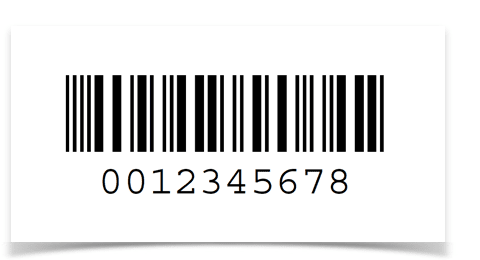
Code 2/5 Interleaved
The barcode is also known as ANSI/AIM ITF 25, ANSI/AIM I-2/5, Uniform Symbology Specification ITF, USS ITF 2/5, ITF, I-2/5, 2 of 5 Interleaved, and 2/5 Interleaved.
The barcode code 2/5 Interleaved is essentially identical to the barcode code 2/5 Industrial with the exception that code 2/5 Interleaved information is encoded with both the bars and spaces.
Application area: compact numeric code

Code 2/5 Matrix
The barcode is also known as 2 of 5 Matrix, and 2/5 Matrix.
The barcode Code 2/5 Matrix is an older discrete, non-self-checking numerical barcode with an optional Modulo 10 check digit.
Application area: industries

Code 39
The barcode is also known as ANSI/AIM Code 39, ANSI/AIM Code 39, Uniform Symbology Specification Code 39, USS Code 39, USS 39, Code 3/9, Code 3 of 9, USD-3, LOGMARS, Alpha39, Code 39 Extended, and Code 39 Full ASCII.
The barcode Code 39, the first alphanumeric barcode, is still widely used. The barcode is suitable for encoding general alphanumeric data. The Barcode 39 is a discrete barcode with variable length.
Application area: military sectors, public services

Code 39 Extended
The barcode is also known as ANSI/AIM Code 39, ANSI/AIM Code 39, Uniform Symbology Specification Code 39, USS Code 39, USS 39, Code 3/9, Code 3 of 9, USD-3, LOGMARS, Alpha39, Code 39 Extended, and Code 39 Full ASCII.
The barcode Code 39 Extended is a universal barcode with many applications in industry. The barcode uses the same code as the barcode Code 39, but permits the use of the complete ASCII character set. This is achieved by displaying all characters that are not directly available in barcode Code 39 by a combination of two characters.
Application area: trade, industries

Identcode
The barcode is also known as German Postal 2 of 5 Identcode, Deutsche Post AG Identcode, Deutsche Frachtpost Identcode, Identcode, CodeIdentcode, and Deutsche Post AG (DHL).
The Barcode Identcode is used for the automatic distribution of mail pieces in freight centres for Deutsche Post AG applications. The barcode is technically a barcode code 2/5 Interleaved, but with special methods that differ from the standard for calculating the check digit and formatting the plain text line.
Application area: postal system

Leitcode
The barcode is also known as German Postal 2 of 5 Leitcode, CodeLeitcode, Leitcode, and Deutsche Post AG (DHL).
The barcode Leitcode is used for applications of Deutsche Post AG for the automatic distribution of mail pieces in freight mail centres. From a technical point of view, the barcode is a barcode code 2/5 Interleaved, in which however special methods are used to calculate the obligatory check digit, as well as for formatting the plain text line.
Application area: postal system
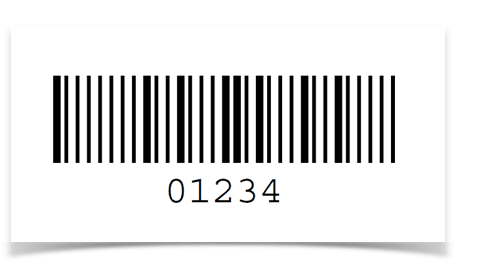
MSI
The barcode is also known as MSI/Plessey, and Modified Plessey.
The MSI barcode was developed by MSI Data Corporation, based on the original Plessey code. It is a non-self-checking barcode that is mainly used in shelf labeling.
Application area: food trade, logistics

MSI (Modulo 10 check digit)
The barcode is also known as MSI/Plessey, and Modified Plessey.
The barcode MSI is a numeric barcode and a modified form of the Plessey code. The barcode can be provided with one or two check digits. If one check digit is encoded, then the check digit must be calculated according to modulo 10. If two check digits are encoded, you can choose between two combinations: modulo 10 + modulo 10 or modulo 11 + modulo 10.
Application area: food trade, logistics

MSI (Modulo 11 check digit)
The barcode is also known as MSI/Plessey, and Modified Plessey.
The barcode MSI is a numeric barcode and a modified form of the Plessey code. The barcode can be provided with one or two check digits. If one check digit is encoded, then the check digit must be calculated according to modulo 10. If two check digits are encoded, you can choose between two combinations: modulo 10 + modulo 10 or modulo 11 + modulo 10.
Application area: food trade, logistics

Onecode
The barcode is also known as Intelligent Mail, OneCode 4CB, USPS 4CB, 4-CB, 4-State Customer Barcode, USPS OneCode Solution Barcode, and USPS IM.
The barcode Onecode (formerly called 4-State Customer Barcode) is a clocked barcode and a newly developed USPS barcode for sorting and tracking mail pieces. The barcode combines the features of (former) barcodes POSTNET and Planet.
Application area: postal system

Patchcode I
The barcode is also known as Kodak Code, and Kodak Path Barcode.
The barcode Patchcode is a simple barcode that does not contain any data but only serves as a process control when scanning documents. The barcode is used, in particular, for separating sheets to divide a stack scan into the individual documents. The barcode consists of six different barcode patterns. This includes patterns generated by the digits 1, 2, 3, 4, and 6, and the character T.
Application area: document management
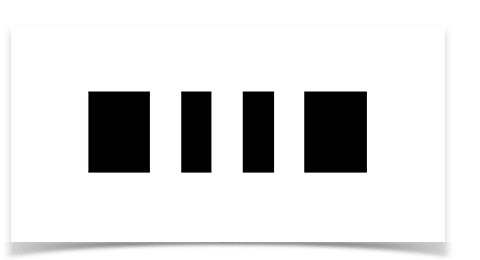
Patchcode II
The barcode is also known as Kodak Code, and Kodak Path Barcode.
The barcode Patchcode is a simple barcode that does not contain any data but only serves as a process control when scanning documents. The barcode is used, in particular, for separating sheets to divide a stack scan into the individual documents. The barcode consists of six different barcode patterns. This includes patterns generated by the digits 1, 2, 3, 4, and 6, and the character T.
Application area: document management

Patchcode III
The barcode is also known as Kodak Code, and Kodak Path Barcode.
The barcode Patchcode is a simple barcode that does not contain any data but only serves as a process control when scanning documents. The barcode is used, in particular, for separating sheets to divide a stack scan into the individual documents. The barcode consists of six different barcode patterns. This includes patterns generated by the digits 1, 2, 3, 4, and 6, and the character T.
Application area: document management

Patchcode IV
The barcode is also known as Kodak Code, and Kodak Path Barcode.
The barcode Patchcode is a simple barcode that does not contain any data but only serves as a process control when scanning documents. The barcode is used, in particular, for separating sheets to divide a stack scan into the individual documents. The barcode consists of six different barcode patterns. This includes patterns generated by the digits 1, 2, 3, 4, and 6, and the character T.
Application area: document management
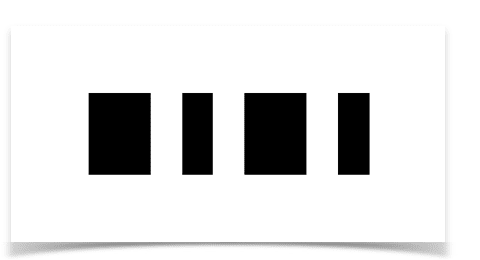
Patchcode T
The barcode is also known as Kodak Code, and Kodak Path Barcode.
The barcode Patchcode is a simple barcode that does not contain any data but only serves as a process control when scanning documents. The barcode is used, in particular, for separating sheets to divide a stack scan into the individual documents. The barcode consists of six different barcode patterns. This includes patterns generated by the digits 1, 2, 3, 4, and 6, and the character T.
Application area: document management

Patchcode VI
The barcode is also known as Kodak Code, and Kodak Path Barcode.
The barcode Patchcode is a simple barcode that does not contain any data but only serves as a process control when scanning documents. The barcode is used, in particular, for separating sheets to divide a stack scan into the individual documents. The barcode consists of six different barcode patterns. This includes patterns generated by the digits 1, 2, 3, 4, and 6, and the character T.
Application area: document management

Pharmacode
The barcode is also know as Pharmacode Laetus, and Pharmaceutical Binary Code.
The barcode Pharmacode is designed for packaging control and safety in the pharmaceutical industry. The barcode consists of two widths of bars with up to 12 bars. The data is a single integer (in the range of 3 to 131070) encoded as a binary number. The Barcode Pharmacode can use several colors as an additional test for packaging accuracy.
Application area: trade, industries

Planet
The barcode is also known as USPS PLANET Barcode, and USPS Confirm Service Barcode.
The barcode Planet (Postal Alpha Numeric Encoding Technique) is a clocked barcode used by the United States Postal Service to identify and track mail pieces during delivery. The barcode was replaced by Intelligent Mail Barcode. The barcode uses numeric input data and a modulo-10 check digit. The barcode has a variable length of 62 to 72 bars.
Application area: postal system
Multi-width Barcode

Codabar
The barcode is also known as ABC Codabar, CodaBar, USD-4, NW-7, Code 2 of 7, Monarch, Code-27, Ames code, Rationalized Codabar, 2 of 7 Code, ANSI/AIM Codabar, Uniform Symbology Specification Codabar, and USS Codabar.
The barcode Codabar is a self-checking barcode with a low error rate. The barcode is a widthmodulated barcode that uses a character set to encode numbers (0-9) plus six special characters ($, -,:, /,., +).
Application area: trade, packaging, library system

Code 11
The barcode is also known as Code11, USD-8, and USD8.
The barcode Code 11 is a barcode developed by Intermec in 1977. The barcode can have any length sequence consisting of the digits 0-9 and the hyphen (-). One or more modulo 11 check digits can be inserted.
Application area: telecommunications

Code 93
The barcode is also known as ANSI/AIM Code 93, ANSI/AIM Code 93, Uniform Symbology Specification Code 93, USS Code 93, USS 93, Code 9/3, USS-93, USD-3, Code 93 Extended, and Code 93 Full ASCII.
The barcode Code 93 is a variable-length barcode and uses four element widths, with each character consisting of three lines and three spaces. The barcode Code 93 was developed to supplement the barcode Code 39 and is a more compact barcode than Code 39. The barcode 93 is a not self-checking barcode.
Application area: postal system

Code 93 Extended
The barcode is also known as ANSI/AIM Code 39, ANSI/AIM Code 39, Uniform Symbology Specification Code 39, USS Code 39, USS 39, Code 3/9, Code 3 of 9, USD-3, LOGMARS, Alpha39, Code 39 Extended, and Code 39 Full ASCII.
The barcode Code 93 extended uses the same coding as the barcode Code 93, but allows the use of all 127 characters of the ASCII character set. Characters that are not available in barcode Code 93 are represented by a combination of control characters.
Application area: industries, postal system

Code 128
The barcode is also known as ANSI/AIM 128, ANSI/AIM Code 128, USS Code 128, Uniform Symbology Specification Code 128, Code 128 Code Set A, Code 128 Code Set B, Code 128 Code Set C, Code 128A, Code 128B, and Code 128C.
The barcode 128 is a general-purpose barcode. The barcode can process all data and it is encoded in a relatively small space by using different compression techniques. Data for barcode Code 128 can be of any length. A barcode Code 128 consists of a leading quiet zone, one of the three start codes, the data itself, a check character, a stop character and a trailing quiet zone.
The barcode Code 128 allows the full ASCII character set to be displayed. The barcode represents characters with three different character sets called A, B, and C.
- A - ASCII 0-96: Control characters, special characters, and capital letters
- B - ASCII 32-127: Special characters, and lowercase letters
- C - Digitals 0..9
Application area: use of complete ASCII character set

Code 128A
The barcode is also known as ANSI/AIM 128, ANSI/AIM Code 128, USS Code 128, Uniform Symbology Specification Code 128, Code 128 Code Set A, Code 128 Code Set B, Code 128 Code Set C, Code 128A, Code 128B, and Code 128C.
The barcode 128 is a general-purpose barcode. The barcode can process all data and it is encoded in a relatively small space by using different compression techniques. Data for barcode Code 128 can be of any length. A barcode Code 128 consists of a leading quiet zone, one of the three start codes, the data itself, a check character, a stop character and a trailing quiet zone.
The barcode Code 128 allows the full ASCII character set to be displayed. The barcode represents characters with three different character sets called A, B, and C.
- A - ASCII 0-96: Control characters, special characters, and capital letters
- B - ASCII 32-127: Special characters, and lowercase letters
- C - Digitals 0..9
Application area: transportation, health care

Code 128B
The barcode is also known as ANSI/AIM 128, ANSI/AIM Code 128, USS Code 128, Uniform Symbology Specification Code 128, Code 128 Code Set A, Code 128 Code Set B, Code 128 Code Set C, Code 128A, Code 128B, and Code 128C.
The barcode 128 is a general-purpose barcode. The barcode can process all data and it is encoded in a relatively small space by using different compression techniques. Data for barcode Code 128 can be of any length. A barcode Code 128 consists of a leading quiet zone, one of the three start codes, the data itself, a check character, a stop character and a trailing quiet zone.
The barcode Code 128 allows the full ASCII character set to be displayed. The barcode represents characters with three different character sets called A, B, and C.
- A - ASCII 0-96: Control characters, special characters, and capital letters
- B - ASCII 32-127: Special characters, and lowercase letters
- C - Digitals 0..9
Application area: transportation, health care
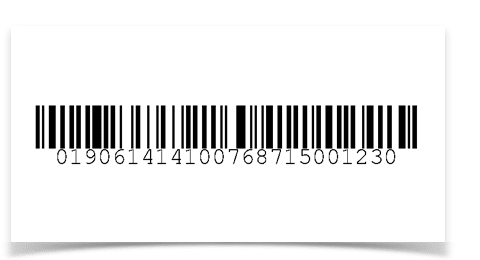
Code 128C
The barcode is also known as ANSI/AIM 128, ANSI/AIM Code 128, USS Code 128, Uniform Symbology Specification Code 128, Code 128 Code Set A, Code 128 Code Set B, Code 128 Code Set C, Code 128A, Code 128B, and Code 128C.
The barcode 128 is a general-purpose barcode. The barcode can process all data and it is encoded in a relatively small space by using different compression techniques. Data for barcode Code 128 can be of any length. A barcode Code 128 consists of a leading quiet zone, one of the three start codes, the data itself, a check character, a stop character and a trailing quiet zone.
The barcode Code 128 allows the full ASCII character set to be displayed. The barcode represents characters with three different character sets called A, B, and C.
- A - ASCII 0-96: Control characters, special characters, and capital letters
- B - ASCII 32-127: Special characters, and lowercase letters
- C - Digitals 0..9
Einsatzgebiet: Transportwesen, Gesundheitswesen

DataBar Expanded
The barcode is also known as GS1 DataBar-14 Expanded, RSS Expanded, and Reduced Space Symbology Expanded.
The barcode DataBar Expanded can identify small objects and carry more information than the current EAN/UPC barcodes. (The DataBar barcodes do not necessarily replace the EAN/UPC barcodes, this is left to the user). The Barcode DataBar Expanded is variable in length, can store up to 74 numeric and 41 alphanumeric characters and is omnidirectional readable.
Application area: GTIN (Global Trade Identification Number), applications in ID fields

DataBar Limited
The barcode is also known as GS1 DataBar-14 Limited, RSS Limited und Reduced Space Symbology Limited.
The barcode DataBar Limited is designed for applications where space is extremely limited and omnidirectional scanning is not required. The barcode can be decoded bidirectionally and uses a mod 89 checksum for error correction. The character set of the barcode contains only the ten digits: 0-9.
Application area: trade, transportation

EAN 2 Supp
The barcode is also known as EAN Supplement 2/Two-digit Add-On, EAN+2, UPC Supplement 2/ Two-digit Add-On, and UPC+2.
The UPC A, UPC E, and EAN 13 barcodes can all have an additional barcode to the right of the main barcode that contains additional information. This second barcode is usually not as large as the primary barcode and can encrypt two or five additional digits.
Application area: ISBN (International Standard Book Number) or ISSN (International Standard Serial Number)

EAN 5 Supp
The barcode is also known as EAN Supplement 5/Two-digit Add-On, EAN+5, UPC Supplement 5/ Two-digit Add-On, and UPC+5.
The UPC A, UPC E, and EAN 13 barcodes can all have an additional barcode to the right of the main barcode that contains additional information. This second barcode is usually not as large as the primary barcode and can encrypt two or five additional digits.
Application area: ISBN (International Standard Book Number) or ISSN (International Standard Serial Number)

EAN 8
The barcode is also known as European Article Number 8, EAN-8 Supplement 5/Five-digit Add-On, EAN-8 Supplement 2/Two-digit Add-On, EAN-8+5, EAN-8+2, EAN8, EAN8+5, EAN13+2, UPC-8, GTIN-8, GS1-8, and EAN/UCC-8.
The barcode EAN 8 is derived from the longer barcode EAN 13. EAN 8 was introduced for use on small objects where a barcode EAN 13 would be too large. The barcode is identical to the 12 digits of the barcode UPC A barcode, except that there are four (instead of six) digits in each of the left and right halves.
Application area: retail (Europe)
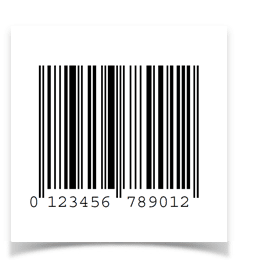
EAN 13
The barcode is also known as European Article Number 13, EAN-13 Supplement 5/Five-digit AddOn, EAN-13 Supplement 2/Two-digit Add-On, EAN-13+5, EAN-13+2, EAN13, EAN13+5, EAN13+2, UPC-13, GTIN-13, GS1-13, and EAN/UCC-13.
The barcode EAN 13 (originally European Article Number and renamed to International Article Number, although the abbreviation EAN is still used) consists of 13 characters, twelve are benefit characters. The barcode always contains a check digit as the 13th digit, which is also always printed in the plain text line.
Application area: international retail and grocery standard (Europe)
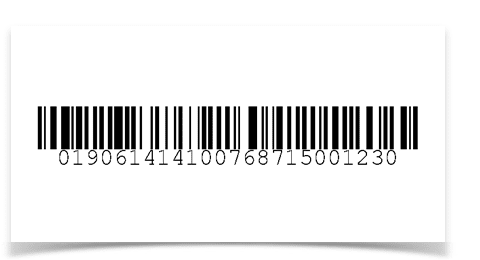
EAN 128
The barcode is also known as EAN-128, UCC-128, USS-128, GS1 128, UCC.EAN-128, GTIN-128, UCC-12, EAN/UCC-13, and EAN/UCC-14.
The barcode EAN 128 is a subset of the barcode Code 128. The barcode was developed to have a global format and standard for the exchange of common data between companies. The barcode provides a list of Application Identifiers (AI). The Application Identifier is a two, three, or four-digit number that identifies the subsequent data type. According to the convention, the Application Identifier is enclosed in brackets when printed below the barcode (the brackets are only for visual clarity and are not encoded in the barcode).
Application area: logistics, retail

Omnidirect
The barcode is also known as RSS14, Reduced Space Symbology 14, and GS1 DataBar-14.
The barcode Omnidirect can be used mainly in retail stores where space for a barcode is limited. The character set of the barcode contains only the ten digits: 0-9. Each barcode is a 14-digit number. There are 13 digits in the data stream: the 14th is a check digit.
Application area: GTIN (Global Trade Identification Number) with limited space

Truncated
The barcode is also known as GS1 DataBar Truncated, RSS-14 Truncated, and Reduced Space Symbology 14 Truncated.
The barcode Truncated is a height-reduced version of the barcode Omnidirect. It is used in applications for small-volume objects that are not detected by omni-directional scanners.
Application area: trade
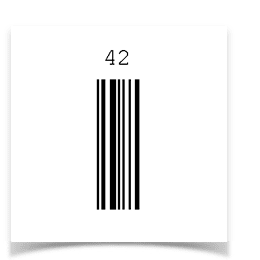
UPC 2 Supp
The barcode is also known as EAN Supplement 2/Two-digit Add-On, EAN+2, UPC Supplement 2/ Two-digit Add-On, and UPC+2.
The UPC A, UPC E, and EAN 13 barcodes can all have an additional barcode to the right of the main barcode that contains additional information. This second barcode is usually not as large as the primary barcode and can encrypt two or five additional digits.
Application area: market analysis

UPC 5 Supp
The barcode is also known as EAN Supplement 5/Two-digit Add-On, EAN+5, UPC Supplement 5/ Two-digit Add-On, and UPC+5.
The UPC A, UPC E, and EAN 13 barcodes can all have an additional barcode to the right of the main barcode that contains additional information. This second barcode is usually not as large as the primary barcode and can encrypt two or five additional digits.
Application area: market analysis

UPC A
The barcode is also known as Universal Product Code version A, UPC-A Supplement 5/Five-digit Add-On, UPC-A Supplement 2/Two-digit Add-On, UPC-A+5, UPC-A+2, UPC Code, UPC Symbol, GTIN-12, GS1-12, and UCC-12.
The UPC A barcode is a 12-digit numeric barcode used in retail applications and is by far the most common and best-known barcode in the United States. The barcode has been developed to uniquely identify a product and its manufacturer.
Application area: retail and grocery standard (United States)

UPC E
The barcode is also known as Universal Product Code version E, UPC-E Supplement 5/Five-digit Add-On, UPC-E Supplement 2/Two-digit Add-On, UPC-E+5, UPC-E+2, UPC-E0, E0, UPC-E1, E1, GTIN-12 with lead "0", GS1-12, and UCC-12.
The barcode UPC E is a compressed version of the barcode UPC A, in which the additional zeros are eliminated. The barcode can be used on small items, since the barcode size is about half of UPC A.
Application area: retail (United States)
1D barcode subdivision
The 1D barcodes are divided into two-width barcodes and multi-width barcodes. The two-width barcode contains characters consisting of narrow and wide elements whose widths are in a constant relationship to one another. The multi-width barcode, in contrast to the two-width barcode, has a greater information density. The bars or gaps can have more than two different widths.
Discover more barcode types
Barcode Solutions with Compart
-
Years of project experience in barcode processing
Compart has one of the largest barcode implementations in the industry in more than 40 countries. The DocBridge® solutions are able to read, create and process / print the world's most popular barcodes for a variety of different data streams (AFP, Prescribe, etc.).
-
Guaranteed readability of barcodes
All Compart solutions include algorithms to prevent the inkjet bleeding effect when printing barcodes. They guarantee 100% readability at all times, even when scaling the barcodes.
-
Concentration on the core business
Users of Compart solutions don't need to worry about establishing barcode processing. The necessary know-how is provided by Compart.
Create barcodes with
professional software
DocBridge products are capable of creating,
managing and using barcodes
to optimize your business processes.


